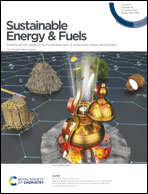A thick titanium dioxide layer formed by Co-doping on a carbon surface promotes the polysulfide-adsorption ability in Li–S batteries†
Abstract
Both biomass carbon and titanium dioxide are beneficial for enhancing the capturing capacities and conversion capacities of polysulfides and achieving excellent lithium–sulfur battery performance. However, the binding ability between highly polar titanium dioxide and weakly polar biomass carbon is weak. The sulfur-loading capacity of titanium dioxide/biomass carbon composite structures is limited and a large number of polysulfides produce shuttle effects. How to enhance the binding ability of titanium dioxide and biomass carbon to achieve high sulfur-loading is an issue that needed to be solved. In this paper, we introduce cobalt into the surface of titanium dioxide/biomass carbon composite structures, adjust the cobalt–titanium molar ratio and obtain composite structures with the strongest binding abilities. The composite structure has high specific capacity and good cycling stability. After 500 cycles at 1.7 A g−1, the reversible capacity is still close to 400 mA h g−1. The high capacity and good cycling stability depend on the ability of composite structures to capture multiple polysulfides and achieve reversible conversion.



 Please wait while we load your content...
Please wait while we load your content...